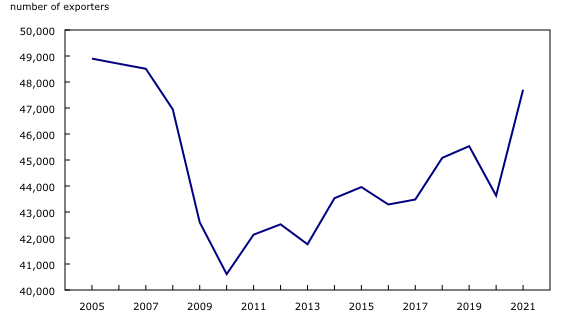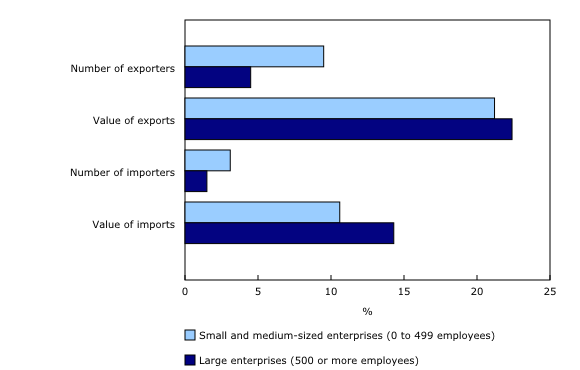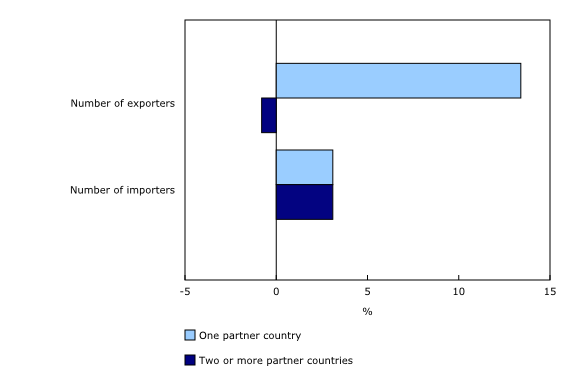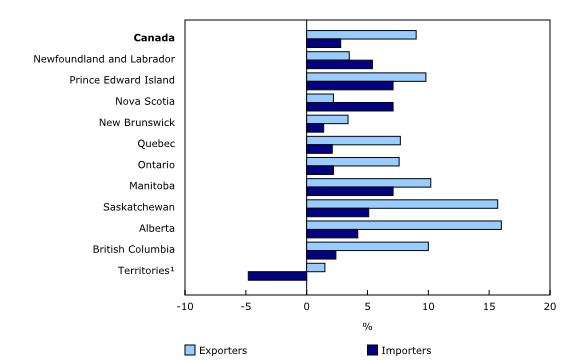Trade by exporter and importer characteristics: Goods, 2021
Released: 2022-05-18
International trade in goods rebounded significantly in 2021, following the unprecedented impact of the COVID-19 pandemic during 2020. The value of Canada's merchandise exports and imports rose to record highs in 2021, while the number of goods exporters and importers both went up year over year.
Led by a rise in the number of small and medium-sized enterprises (SMEs) that export, the number of goods exporters went up by 9.3% to reach 47,701 in 2021. This total, which surpassed the pre-pandemic level of 2019, was the highest level recorded since 2007. Following the 2008 financial crisis, the number of exporters declined until 2011 and remained below pre-financial crisis levels.
On the other hand, the number of importing enterprises grew 3.1% to reach 160,254 in 2021, but was still below the pre-pandemic level of 2019. SMEs led the growth in the number of importers, while large enterprises had more growth in the value of imports. This pattern held true for importers during the economy's recovery in 2010 from the 2008 financial crisis.
Value of merchandise trade by two-way traders surpasses $1 trillion
Overall, 177,799 Canadian enterprises traded goods internationally in 2021, of which 30,156 (17.0%) were two-way traders. These businesses, which are both importers and exporters, are strongly integrated in global supply chains. Over two-fifths of two-way traders were manufacturing enterprises, despite manufacturers comprising 1 in 6 of all traders. By value, two-way traders imported and exported just over $1.0 trillion worth of goods in 2021, accounting for 87.7% of total merchandise trade value.
The rest of traders were either exporters only (17,545) or importers only (130,098). Compared with pre-pandemic figures from 2019, the number of exporters only was up 15.2%, while the number of two-way traders (-0.5%) and importers only (-2.3%) had not yet fully recovered by 2021.
Small and medium-sized enterprises lead recovery from the pandemic in the number of traders
The vast majority (98.8%) of traders in 2021 were SMEs, although they accounted for less than half (45.9%) of Canada's total merchandise trade value. Hence, SMEs typically drive fluctuations in the number of traders, while any type of enterprise can contribute to fluctuations in the value of trade.
Both the number of exporters and the value of exports went up in 2021 as the economy continued to recover from the initial effects of the pandemic. A year-over-year rise in the number of SME exporters (+9.5%), higher than that of large exporters (+4.5%), was primarily responsible for an upswing in the number of exporters. In terms of export value, both SMEs (+21.2%) and large enterprises (+22.4%) contributed to the recovery.
Like with exporters, the number of SME importers (+3.1%) rose faster than the number of large importing enterprises (+1.5%) in2021. On the other hand, the growth in SME import value (+10.6%) was outpaced by that of large enterprises (+14.3%).
Significant increase in the number of enterprises trading with the United States
Canada and the United States share a deep and longstanding relationship that is vital for Canadian traders. The United States was the only export destination for nearly two-thirds (63.9%) of all Canadian exporters in 2021.
Between 2020 and 2021, the number of exporters to the United States increased by a record amount (+4,318), while the number of enterprises importing from the United States went up by 3,192, the highest increase since 2010.
On the other hand, the number of exporters to other major regions, notably Europe (-313) and Asia (-299), declined for a second consecutive year. Exporters to Asia dropped to the lowest level since 2010, mainly among enterprises exporting to China, Hong Kong and Thailand.
Nevertheless, the number of enterprises that imported goods originating from Europe (+2,511) and Asia (+1,271) went up in 2021. Germany and Italy led the increase for Europe while, for Asia, more enterprises imported from India and China.
More exporters sell to one partner country only
The ability to access foreign markets is an important consideration for Canadian enterprises to grow their business, especially in the context of disruptions within international supply chains.
The increase in 2021 in the number of exporting enterprises (+4,071) was driven by a rise in those exporting to one partner country only (+4,168), mainly SMEs that exported exclusively to the United States (+4,332). At the same time, the number of enterprises exporting to multiple countries declined slightly (-97) for a second consecutive year. In 2021, 26.1% of all exporters sold goods to multiple partner countries, the lowest share on record.
In comparison, the number of importers that bought goods from one partner country only (+2,492) or from multiple partner countries (+2,292) both went up annually. In 2021, nearly half of all importers (48.3%) purchased goods from multiple partner countries and they were responsible for almost all of Canada's import value (97.3%).
Western Canada has largest recovery in number of exporters
Recovery in the number of traders was widespread across Canada. On a provincial basis, the number of exporting establishments rose in all Canadian provinces and the territories in 2021, while the number of importers went up in all regions except the territories (-4.8%).
Exporter growth was highest in western Canada, where Manitoba (+10.2%), Saskatchewan (+15.7%), Alberta (+16.0%) and British Columbia (+10.0%) all recorded double-digit growth related to more exporters within services-producing industries.
Note to readers
The Trade by Exporter Characteristics: Goods and Trade by Importer Characteristics: Goods programs are an initiative at Statistics Canada undertaken to analyze the business characteristics of exporters and importers in Canada. These estimates are formed by linking customs trade data records to business entities in Statistics Canada's Business Register.
Data on exports to the United States are collected by the US Census Bureau and transmitted to Statistics Canada as part of the Canada–US data exchange, while data on exports to the rest of the world are collected jointly by Statistics Canada and the Canada Border Services Agency.
Customs import data are collected jointly by Statistics Canada and the Canada Border Services Agency.
The Business Register contains the complete operating and legal structure of enterprises operating in Canada, as well as their key characteristics, such as employment, and North American Industry Classification System code.
Survey definitions
This release contains information at both the enterprise and establishment levels. An enterprise is defined as the statistical unit that directs and controls the allocation of resources relating to its domestic operations, and for which consolidated financial statements are maintained. An establishment is the smallest statistical unit within an enterprise structure and better reflects the primary industrial activity and the province of the exporter and importer. The two measures generate a different number of exporting and importing units, as well as a different industry allocation of these units.
Small enterprises have fewer than 100 employees, including those that did not report any employment. Medium-sized enterprises have 100 to 499 employees, while large enterprises have 500 or more employees.
Country of origin is the country of production or the country in which the final stage of production or manufacture occurs.
In this release, data disseminated at the provincial level are conceptually different from customs-based merchandise export and import data. Provincial data for the Trade by Exporter Characteristics: Goods and Trade by Importer Characteristics: Goods programs are based on the province where the exporter and the importer are located. Goods can be shipped to other provinces for final consumption or can be shipped from other provinces when leaving Canada. Customs-based merchandise imports are based on the province of clearance: This is the province where the goods are cleared at customs, but this may not always be the province in which the importer is located. Customs-based merchandise exports are based on the province of origin: This is the province where the goods are grown, produced, extracted or manufactured.
Detailed information on concepts and methodology relating to this release is available on the Trade by Exporter Characteristics: Goods survey page and the Trade by Importer Characteristics: Goods survey page.
Survey coverage
In this release, the total value of exports and imports refers to the part of the annual domestic export and import value (customs basis) that can be linked to specific entities in the Business Register each year. Annual domestic export and import values (customs basis) can be obtained from the Canadian International Merchandise Trade Web Application and Table 12-10-0119-01. Additional information and definitions related to domestic merchandise exports and imports are available on the survey page for Canadian International Merchandise Trade (Customs Basis).
Export and import data are available for the reference period from 2005 to 2021. Each year from 2005 to 2021, the total number of identified exporting and importing enterprises accounted for 96% and 98% of the total domestic export and import value, respectively. Throughout this release, the percentage share of export sales and import purchases corresponds to the share of the annual domestic export and import value for which there was an identified exporter and importer. The number of exporters and importers corresponds to the number of exporters and importers identified within the Business Register by the Trade by Exporter Characteristics: Goods and Trade by Importer Characteristics: Goods programs.
Products
The data visualization product "Trade in Goods by Exporter and Importer Characteristics: Interactive Tool," which is part of Statistics Canada – Data Visualization Products (71-607-X), is now available.
The updated Canada and the World Statistics Hub (13-609-X) is available online. This product illustrates the nature and extent of Canada's economic and financial relationship with the world using interactive graphs and tables. This product provides easy access to information on trade, investment, employment and travel between Canada and a number of countries, including the United States, the United Kingdom, Mexico, China and Japan.
The Methodological Guide: Canadian System of Macroeconomic Accounts (13-607-X) is available.
The User Guide: Canadian System of Macroeconomic Accounts (13-606-G) is also available. This publication will be regularly updated to maintain its relevance.
Contact information
For more information, or to enquire about the concepts, methods or data quality of this release, contact us (toll-free 1-800-263-1136; 514-283-8300; infostats@statcan.gc.ca) or Media Relations (statcan.mediahotline-ligneinfomedias.statcan@statcan.gc.ca).
- Date modified:







